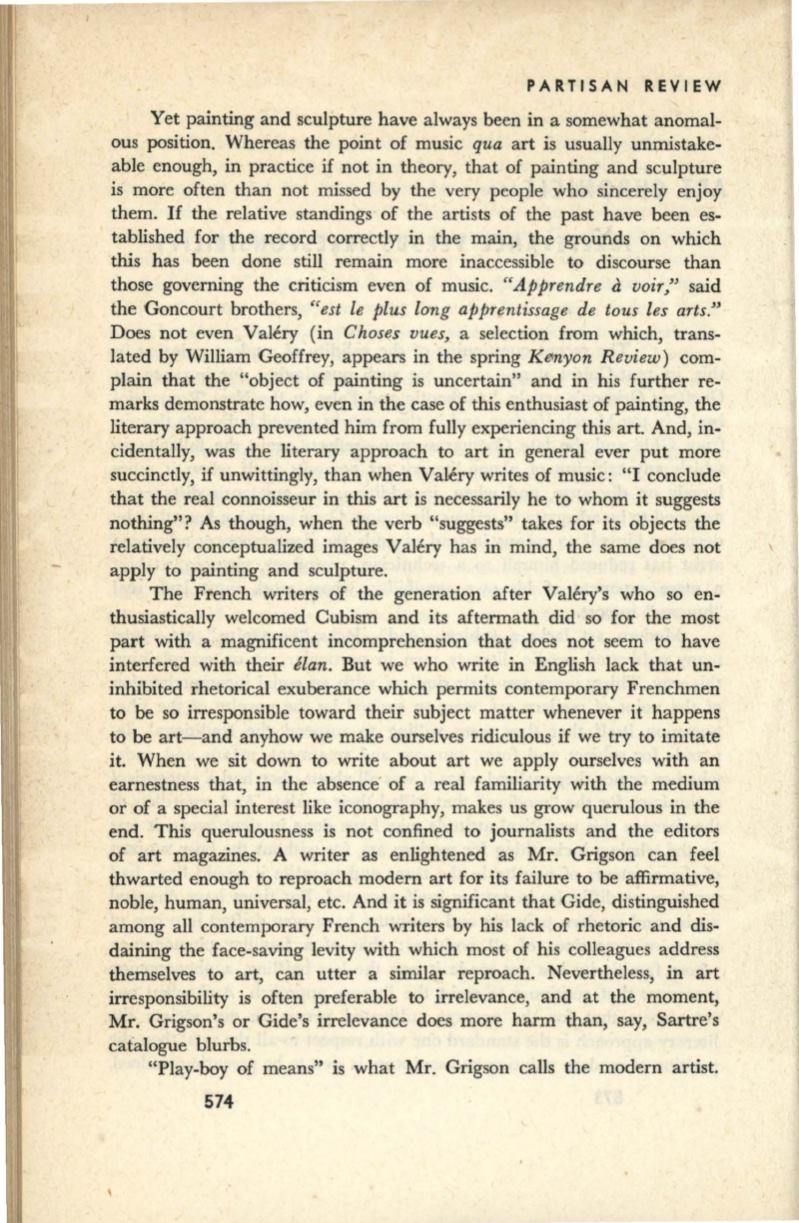
PARTISAN REVIEW
Yet painting and sculpture have always been in a somewhat anomal–
ous position. Whereas the point of music
qua
art is usually unmistake–
able enough, in practice
if
not in theory, that of painting and sculpture
is more often than not missed by the very people who sincerely enjoy
them.
If
the relative standings of the artists of the past have been es–
tablished for the record correctly in the main, the grounds on which
this has been done still remain more inaccessible to discourse than
those governing the criticism even of music.
"Apprendre
a
voir,"
said
the Goncourt brothers,
"est le plus long apprentissage de tous les arts."
Does not even Valery (in
Choses vues,
a selection from which, trans–
lated by William Geoffrey, appears in the spring
Ke.nyon Review)
com–
plain that the "object of painting is uncertain" and in his further re–
marks demonstrate how, even in the case of this enthusiast of painting, the
literary approach prevented him from fully experiencing this art. And, in–
cidentally, was the literary approach to art in general ever put more
succinctly, if unwittingly, than when Valery writes of music: "I conclude
that the real connoisseur in this art is necessarily he to whom it suggests
nothing"? As though, when the verb "suggests" takes for its objects the
relatively conceptualized images Vah!ry has in mind, the same does not
apply to painting and sculpture.
The French writers of the generation after Valery's who so en–
thusiastically welcomed Cubism and its aftermath did so for the most
part with a magnificent incomprehension that does not seem to have
interfered with their
elan.
But we who write in English lack that un–
inhibited rhetorical exuberance which permits contemporary Frenchmen
to be so irresponsible toward their subject matter whenever it happens
to be art-and anyhow we make ourselves ridiculous if we try to imitate
it. When we sit down to write about art we apply ourselves with an
earnestness that, in the absence of a real familiarity with the medium
or of a special interest like iconography, makes us grow querulous in the
end. This querulousness is not confined to journalists and the editors
of art magazines. A writer as enlightened as Mr. Grigson can feel
thwarted enough to reproach modern art for its failure to be affirmative,
noble, human, universal, etc. And it is significant that Gide, distinguished
among all contemporary French writers by his lack of rhetoric and dis–
daining the face-saving levity with which most of his colleagues address
themselves to art, can utter a similar reproach. Nevertheless,
in
art
irresponsibility is often preferable to irrelevance, and at the moment,
Mr. Grigson's or Gide's irrelevance does more harm than, say, Sartre's
catalogue blurbs.
"Play-boy of means" is what Mr. Grigson calls the modern artist.
574


